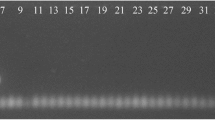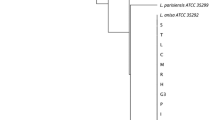Abstract
A total of 25 gyrB gene sequences from 20 Legionella pneumophila subsp. pneumophila strains and five L. pneumophila subsp. fraseri strains were obtained and analyzed, and a multiplex PCR for the simultaneous detection of Legionella bozemanae, Legionella longbeachae, Legionella micdadei and Legioenella pneumophila, and two single PCRs for the differentiation of L. pneumophila subsp. pneumophila and L. pneumophila subsp. fraseri were established. The multiplex PCR method was shown to be highly specific and reproducible when tested against 41 target strains and 17 strains of other bacteria species. The sensitivity of the multiplex PCR was also analyzed and was shown to detect levels as low as 1 ng of genomic DNA or 10 colony-forming units (CFUs) per milliliter in mock water samples. Sixty-three air conditioner condensed water samples from Shanghai City were examined, and the result was validated using 16S rRNA sequencing. The data reported here demonstrate that the multiplex PCR method described is efficient and convenient for the detection of Legionella species in water samples. Twenty L. pneumophila subsp. pneumophila strains and five L. pneumophila subsp. fraseri strains were used for the validation of the two L. pneumophila subspecies-specific PCR methods, and the results indicated that the two PCR methods were both highly specific and convenient for the identification of L. pneumophila at the subspecies level.





Similar content being viewed by others
References
Bastin DA, Reeves PR (1995) Sequence and analysis of the O antigen gene (rfb) cluster of Escherichia coli O111. Gene 164:17–23
Berger P, Papazian L, Drancourt M, La Scola B, Auffray JP, Raoult D (2006) Ameba-associated microorganisms and diagnosis of nosocomial pneumonia. Emerg Infect Dis 12:248–255
Blyth CC, Adams DN, Chen SC (2009) Diagnostic and ty** methods for investigating Legionella infection. N S W Public Health Bull 20:157–161
Brenner DJ, Steigerwalt AG, Epple P, Bibb WF, McKinney RM, Starnes RW, Colville JM, Selander RK, Edelstein PH, Moss CW (1988) Legionella pneumophila serogroup Lansing 3 isolated from a patient with fatal pneumonia, and descriptions of L. pneumophila subsp. pneumophila subsp. nov., L. pneumophila subsp. fraseri subsp. nov., and L. pneumophila subsp. pascullei subsp. nov. J Clin Microbiol 26:1695–1703
Carratalà J, Garcia-Vidal C (2010) An update on Legionella. Curr Opin Infect Dis 23:152–157
Fields BS, Benson RF, Besser RE (2002) Legionella and Legionnaires' disease: 25 years of investigation. Clin Microbiol Rev 15:506–526
Hayden RT, Uhl JR, Qian X, Hopkins MK, Aubry MC, Limper AH, Lloyd RV, Cockerill FR (2001) Direct detection of Legionella species from bronchoalveolar lavage and open lung biopsy specimens: comparison of LightCycler PCR, in situ hybridization, direct fluorescence antigen detection, and culture. J Clin Microbiol 39:2618–2626
Herpers BL, de Jongh BM, van der Zwaluw K, van Hannen EJ (2003) Real-time PCR assay targets the 23S–5S spacer for direct detection and differentiation of Legionella spp. and Legionella pneumophila. J Clin Microbiol 41:4815–4816
Izumi S, Yamamoto M, Suzuki K, Shimizu A, Aranishi F (2007) Identification and detection of Pseudomonas plecoglossicida isolates with PCR primers targeting the gyrB region. J Fish Dis 30:391–397
Joseph CA, Ricketts KD (2010) Legionnaires disease in Europe 2007–2008. Euro Surveill 15:19493
Kakinuma K, Fukushima M, Kawaguchi R (2003) Detection and identification of Escherichia coli, Shigella, and Salmonella by microarrays using the gyrB gene. Biotechnol Bioeng 83:721–728
Kang Y, Takeda K, Yazawa K, Mikami Y (2009) Phylogenetic studies of Gordonia species based on gyrB and secA1 gene analyses. Mycopathologia 167:95–105
Kirby BM, Everest GJ, Meyers PR (2010) Phylogenetic analysis of the genus Kribbella based on the gyrB gene: proposal of a gyrB-sequence threshold for species delineation in the genus Kribbella. Antonie Leeuwenhoek 97:131–142
Ko KS, Lee HK, Park MY, Park MS, Lee KH, Woo SY, Yun YJ, Kook YH (2002) Population genetic structure of Legionella pneumophila inferred from RNA polymerase gene (rpoB) and DotA gene (dotA) sequences. J Bacteriol 184:2123–2130
Ko KS, Hong SK, Lee KH, Lee HK, Park MY, Miyamoto H, Kook YH (2003) Detection and identification of Legionella pneumophila by PCR-restriction fragment length polymorphism analysis of the RNA polymerase gene (rpoB). J Microbiol Methods 54:325–337
Lane DJ, Pace B, Olsen GJ, Stahl DA, Sogin ML, Pace NR (1985) Rapid determination of 16S ribosomal RNA sequences for phylogenetic analyses. Proc Natl Acad Sci USA 82:6955–6959
McNally C, Hackman B, Fields BS, Plouffe JF (2000) Potential importance of Legionella species as etiologies in community acquired pneumonia (CAP). Diagn Microbiol Infect Dis 38:79–82
Muder RR, Yu VL (2002) Infection due to Legionella species other than L. pneumophila. Clin Infect Dis 35:990–998
Murdoch DR (2003) Diagnosis of Legionella infection. Clin Infect Dis 36:64–69
Neil K, Berkelman R (2008) Increasing incidence of legionellosis in the United States, 1990–2005: changing epidemiologic trends. Clin Infect Dis 47:591–599
Palusińska-Szysz M, Cendrowska-Pinkosz M (2009) Pathogenicity of the family Legionellaceae. Arch Immunol Ther Exp (Warsz) 57:279–290
Park SH, Kim HJ, Kim JH, Kim TW, Kim HY (2007) Simultaneous detection and identification of Bacillus cereus group bacteria using multiplex PCR. J Microbiol Biotechnol 17:1177–1182
Ratcliff RM, Donnellan SC, Lanser JA, Manning PA, Heuzenroeder MW (1997) Interspecies sequence differences in the Mip protein from the genus Legionella: implications for function and evolutionary relatedness. Mol Microbiol 25(6):1149–1158
Reischl U, Linde HJ, Lehn N, Landt O, Barratt K, Wellinghausen N (2002) Direct detection and differentiation of Legionella spp. and Legionella pneumophila in clinical specimens by dual-color real-time PCR and melting curve analysis. J Clin Microbiol 40:3814–3817
Ricketts KD, Joseph CA (2007) Legionnaires' disease in Europe: 2005–2006. Euro Surveill 12(12):E7–E8
Riffard S, Vandenesch F, Reyrolle M, Etienne J (1996) Distribution of mip-related sequences in 39 species (48 serogroups) of Legionellaceae. Epidemiol Infect 117:501–506
Roig J, Sabria M, Pedro-Botet ML (2003) Legionella spp.: community acquired and nosocomial infections. Curr Opin Infect Dis 16:145–151
Selander RK, McKinney RM, Whittam TS, Bibb WF, Brenner DJ, Nolte FS, Pattison PE (1985) Genetic structure of populations of Legionella pneumophila. J Bacteriol 163:1021–1037
Stølhaug A, Bergh K (2006) Identification and differentiation of Legionella pneumophila and Legionella spp. with real-time PCR targeting the 16S rRNA gene and species identification by mip sequencing. Appl Environ Microbiol 72:6394–6398
Su HP, Tung SK, Tseng LR, Tsai WC, Chung TC, Chang TC (2009) Identification of Legionella species by use of an oligonucleotide array. J Clin Microbiol 47:1386–1392
Tabacchioni S, Ferri L, Manno G, Mentasti M, Cocchi P, Campana S, Ravenni N, Taccetti G, Dalmastri C, Chiarini L, Bevivino A, Fani R (2008) Use of the gyrB gene to discriminate among species of the Burkholderia cepacia complex. FEMS Microbiol Lett 281:175–182
Tamura K, Dudley J, Nei M, Kumar S (2007) MEGA4: molecular evolutionary genetics analysis (MEGA) software version 4.0. Mol Biol Evol 24:1596–1599
Teh CS, Chua KH, Thong KL (2010) Simultaneous differential detection of human pathogenic and nonpathogenic Vibrio species using a multiplex PCR based on gyrB and pntA genes. J Appl Microbiol 108:1940–1945
Warsen AE, Krug MJ, LaFrentz S, Stanek DR, Loge FJ, Call DR (2004) Simultaneous discrimination between 15 fish pathogens by using 16S ribosomal DNA PCR and DNA microarrays. Appl Environ Microbiol 70:4216–4221
Wilson DA, Yen-Lieberman B, Reischl U, Gordon SM, Procop GW (2003) Detection of Legionella pneumophila by real-time PCR for the mip gene. J Clin Microbiol 41:3327–3330
Wu JG, Wang JF, Zhang XH, Zhang SS, Hu XF, Chen JS (2010) A gyrB-targeted PCR for rapid identification of Paenibacillus mucilaginosus. Appl Microbiol Biotechnol 87:739–747
Yin H, Cao L, Qiu G, Wang D, Kellogg L, Zhou J, Liu X, Dai Z, Ding J (2008) Molecular diversity of 16S rRNA and gyrB genes in copper mines. Arch Microbiol 189:101–110
Yu VL, Plouffe JF, Pastoris MC, Stout JE, Schousboe M, Widmer A, Summersgill J, File T, Heath CM, Paterson DL, Chereshsky A (2002) Distribution of Legionella species and serogroups isolated by culture in patients with sporadic community-acquired legionellosis: an international collaborative survey. J Infect Dis 186:127–128
Acknowledgements
This work was supported by grants from the National High-Tech R&D Program of China (863 Program) (Grant Nos. 2006AA020703, 2006AA06Z409 and 2009AA06Z403), and the National Key Programs for Infectious Diseases of China (Grant Nos. 2008ZX10004-002, 2008ZX10004-009, 2009ZX10004-108 and 2008ZX10003-005). We would like to thank Ms. Gangyi Wang for supplying the condensed water samples.
Author information
Authors and Affiliations
Corresponding author
Rights and permissions
About this article
Cite this article
Zhou, G., Cao, B., Dou, Y. et al. PCR methods for the rapid detection and identification of four pathogenic Legionella spp. and two Legionella pneumophila subspecies based on the gene amplification of gyrB . Appl Microbiol Biotechnol 91, 777–787 (2011). https://doi.org/10.1007/s00253-011-3283-6
Received:
Revised:
Accepted:
Published:
Issue Date:
DOI: https://doi.org/10.1007/s00253-011-3283-6




